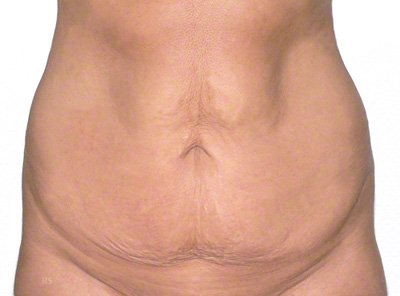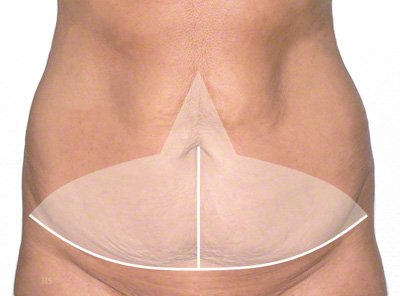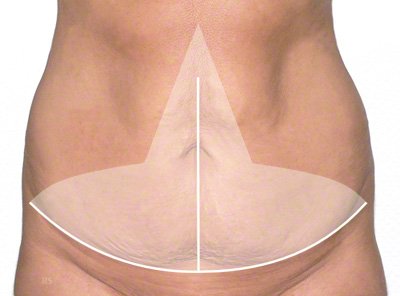Many patients want a tummy tuck or abdominoplasty after pregnancies (often multiple pregnancies) or after massive weight loss due to previous severe overweight (obesity).
If we at Yuveo Düsseldorf perform the tightening with other operations to restore the pre-pregnancy state, then we also speak of the so-called mommy makeover or mommy correction.
On the one hand, the abdominal skin can be massively stretched. On the other hand, the abdominal wall, which consists of the abdominal muscles and firm fibrous layers, is often also dilated. The latter can also lead to a so-called pot belly in slim women. A simple tummy tuck at skin level would not be sufficient here. An internal tightening of the abdominal wall is also important.
Excessive weight loss, which in principle results in similar changes, is also often a reason for a tummy tuck, with a sometimes enormous excess of skin and fat(fat apron) in the foreground.
The consultation and the entire treatment are carried out by specialists in plastic and aesthetic surgery.
You can make an appointment for a specialist consultation using the contact form or give us a call.
Contents
Yuveo Clinic
Special features of the tummy tuck
Not every surgical technique we use at the Yuveo Clinic Düsseldorf requires the navel to be moved.
Classic tummy tuck
Mini tightening of the abdominal wall
Major tightening surgery
Surgical procedure for a tummy tuck
Smoking should be stopped for 2 weeks before a tummy tuck to minimize the risk of wound healing disorders. Once the wound has healed, the risk is no longer present.
The operation takes about 2 hours. It is performed under general anesthesia. The incision depends on the amount of tissue to be reduced. Depending on the extent of the tummy tuck, an inpatient stay of 1-2 days is recommended – longer if there is a lot of excess tissue.
The basic principle of a tummy tuck is to remove excess skin and fatty tissue.
This is achieved through an incision that runs over the mons pubis and then laterally upwards towards the pubic bone blades. Our plastic surgeons can adapt the line to the swimwear or underwear. In order to mobilize as much skin as possible, the fatty tissue must be detached from the abdominal wall – up to the lower edge of the sternum. This is the only way to ensure that the tummy tuck also has an effect on the upper abdomen.
We cut out the navel and sew it into its new position. Of course, we try to produce as few scars as possible and, if possible, avoid the vertical scar that runs from the mons pubis to the navel in the midline.
However, there are findings that make a tummy tuck with an additional scar running along the midline necessary:
Mini tummy tuck
Sometimes we cannot remove enough skin to hide the former umbilical area in the transverse scar. The defect is then closed with a small vertical suture.
Major tummy tuck
The excess skin is so large that skin must also be removed in a vertical direction. This results in a vertical scar in the midline. The incision pattern resembles a lily. This is why this technique is called ‘fleur de lis’. The large incision leads to a longer downtime and prolonged wound healing.



Frequently asked questions about abdominoplasty
What should I bear in mind when combining liposuction?
Abdominoplasty can also be combined with liposuction.
In some cases, the abdominal skin is sagging, but there is also a significant excess of fatty tissue. In such situations, liposuction can be performed first, followed by abdominoplasty.
Some plastic surgeons perform both procedures directly one after the other in order to avoid a second anesthetic. Others perform the procedure twice to minimize complications as much as possible.
The tummy can often be significantly improved aesthetically through the tightening operation by performing liposuction on the hips at the same time, if there is a problem area here, in order to strengthen the waistline.
The surgical effort is only slightly higher than with the standard procedure.
The follow-up treatment does not differ significantly, especially as a certain period of rest and abstinence from sport is to be expected in both cases.
What is meant by an "internal corset" during abdominal wall surgery?
Tissue overstretching often also affects the abdominal wall or the abdominal muscles.
If the two straight abdominal muscles diverge, a so-called rectus diastasis is present in addition to abdominal skin sagging.
At Yuveo Düsseldorf, we can counteract this condition with the “inner corset” . With the help of a special suturing technique, which does not grip the muscle but its firm sheath, internal tightening is possible both horizontally and vertically.
How is the navel moved?
We move the navel as part of classic abdominal wall surgery. The aim is to make the new navel look as natural as possible.
The skillful shaping of the navel is an important part of the procedure, as the navel cannot be hidden in a bikini or swimming trunks. This is why we form a natural-looking funnel in which the scar will ultimately be largely invisible.
In this context, we can also form the popular “champagne flute” in this zone on request.
What do I need to bear in mind after a tummy tuck?
The aftercare depends on the extent of the operation and the previous findings. With a mini tummy tuck, you will be fit again more quickly than with a large ‘fleur de lis’ tummy tuck. There are various things to consider in the post-operative treatment of a tummy tuck. Post-operative treatment is also more difficult if complications occur. The costs can also be higher as a result.
The most important things for the normal case are as follows:
Drains
The drains are left in place for 2-5 days after the tummy tuck, depending on the amount of drainage.
The behavior
… after the procedure plays a decisive role.
Particularly in the first 3 weeks, care should be taken not to strain the suture on the lower abdomen too much so that it does not stretch. You should therefore sleep in a jackknife-like position on your back to reduce the tension at the suture site. You should therefore also walk and stand in a slightly bent position after the tummy tuck.
Stool regulation is just as important and can be supported by light laxatives if there is a risk of constipation. Constipating and flatulent foods must be avoided. If the patient presses harder, the inner corset sutures can stretch more quickly than desired.
Compression
For professional aftercare, it is particularly important to remain calm in the first 24 hours after the operation so that a small vessel that has been cauterized or ligated does not burst open again. A compression bandage for one night can further reduce the likelihood of bleeding. In the first few days or weeks, swelling and slight bruising (also on the sides) of the skin are normal. A compression girdle should be worn for up to 6 weeks after the tummy tuck.
Threads
Self-dissolving stitches do not need to be removed. Non-self-dissolving stitches are removed after 14 days at the earliest.
Showers
Due to the proximity of the pubic area, waterproof dressings are usually not used. Showering is permitted shortly after the drains have been removed (2-5 days). Before that, the dressing must remain dry.
Sport
After the operation, sports that lead to movement of the abdomen and/or are strenuous should be avoided for 4-6 weeks.
These descriptions are only intended as a guide. The post-treatment of the tummy tuck may also deviate from these descriptions with other plastic surgeons.
Is it possible to cover the costs?
It is becoming increasingly rare for health insurance companies to cover the costs of a tummy tuck. However, there is a chance in extreme cases with a medical condition, similar to breast reduction. Further information in the article Cost coverage for a tummy tuck.
How much does a tummy tuck cost?

- the extent of the operation
- the length of the hospital stay
- of the anesthesia costs
- finally, of course, by the plastic surgeon
Costs of a small tummy tuck | mini abdominoplasty
For mini-abdominoplasty (= small tummy tuck), the costs consist of the surgical fee plus anesthesia. In some clinics, the costs for the hospital stay are added to this.
Costs of a standard tummy tuck
The normal tummy tuck is significantly more expensive than its smaller version. You will have to expect higher costs for the actual operation.
For more details and exact costs, please ask our Yuveo team in Düsseldorf.
Fact check
- Practitioners: Dr. Schumann and Dr. Schumann-Averkiou
Treatment duration:
about 2 hours- Anesthesia:
General anesthesia - Hospital stay:
inpatient, 1 to 2 days - Follow-up treatment:
Compression underwear for 6 weeks, 3 weeks rest position - Stitches:
Stitches are removed after 14 days. - Sport:
Avoid sport for up to 6 weeks after surgery. - Costs: on request
Further information and explanation of technical terms
- The upper tummy tuck is rarely performed.
- Fat apron removal – a variant of abdominal wall surgery
- Which operations is a tummy tuck often combined with?
- What complications can occur during a tummy tuck?
Technical terms:
- Abdominoplasty = abdominoplasty, abdominoplasty, classic abdominoplasty
- Obesity = obesity
- Obesity permagna = extreme form of obesity
- Mini abdominoplasty = small tummy tuck


